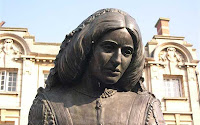In a time when open adultery was officially frowned upon and perpetrators faced social stigma and exclusion, (unlike to today when it is everyday life to a senile Italian prime ministers, dwarfish French presidents, and the despicable classe politique in general) George Eliot was born. He was to become one of the most read, most mocked, and best earning writers of the 19th century. Oh yes, and he was a she.
In 1854, Miss Marian Evans set sail for the continent. Accompanying her was neither a maid nor a chaperon but a male companion by name of George Henry Lewes. George Henry Lewes was a fellow journalist of Marian Evans', not related to her, and already married to another woman. Scandalmongers set to work immediately.
In this most hypocritical of ages called the Victorian era, when bigots made the rules and double standards where the norm, the action taken by Marian Evans and George Henry Lewes was tantamount to social suicide. In keeping with the twisted morals of the time, becoming a social outcast was reserved for women. While George Henry Lewes' behavior was reprehensible, Marian Evans might just as well have dropped dead.
Upon the return from the continent, Marian Evans was ostracized by her social and professional peers; she became a pariah to society, unclean, a person you didn't want to know for fear that her sin might rub off on you like a sickness. It excluded her from going to public places like theaters, she would not receive any invitations to dinners or soirees anymore, nor could she visit any friends. It meant total isolation. She exuded stigma like a miasma.
Consequently, she retired to Coventry. There she found time and quiet to pursue her favorite dream: She wanted to write a novel. Her first finished manuscript was ‘Scenes Of Clerical Life’ and was published under her chosen nom de plume. It was the birth of George Eliot.
Later books such as ‘Adam Bede’, ‘The Mill On The Floss’, and ‘Middlemarch’ assured her of millions of readers and made her very, very rich. ‘Romola’, the historical novel set in Florence, made her £7,000, which translates into half a million pounds in today’s money. Her novels transformed a farmer’s daughter into one of the most read novelists in the 19th century. In typical Victorian duplicity, her work was praised in the highest terms while her person was reviled and ridiculed at the same time.
Brenda Maddox’ ‘George Eliot’ was published by Harper Press. There are enough plodding biographies on George Eliot on the market, but Maddox takes a quirky and slanted look at the life of Marian Evans. She concentrates on the private person and works out the influence George Henry Lewes had on her writing. At the same time, she shows how she managed to keep the influence of the public picture painted in her novels to a minimum.
The end result is a rather short but very readable book that gives an insight into the times and circumstances of George Eliot. It paints a picture of a time that gave birth to a type of novel equally time bound by its writing convention. If you don’t like the too prosy biographies or want to complement the rather dry picture they paint, this book is definitely worth reading.








No comments:
Post a Comment